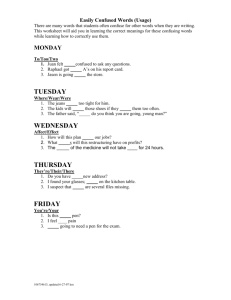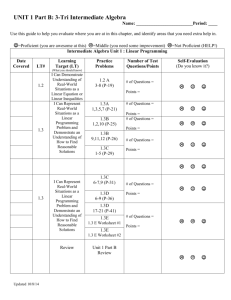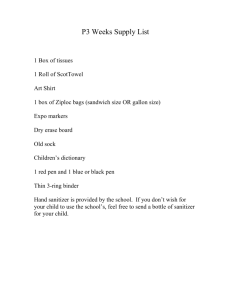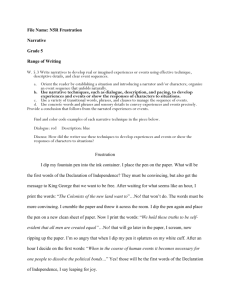Volume loss of an aquaculture net pen due to current
advertisement
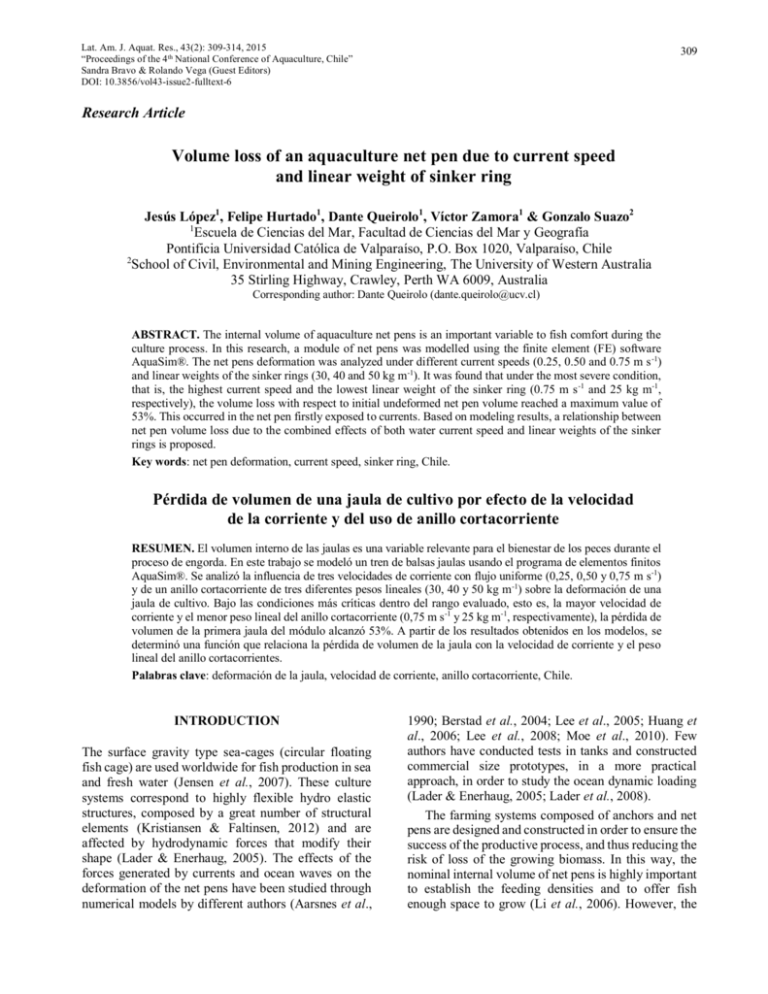
Lat. Am. J. Aquat. Res., 43(2): 309-314, 2015 Volume loss of an aquaculture net pen “Proceedings of the 4th National Conference of Aquaculture, Chile” Sandra Bravo & Rolando Vega (Guest Editors) DOI: 10.3856/vol43-issue2-fulltext-6 309 Research Article Volume loss of an aquaculture net pen due to current speed and linear weight of sinker ring Jesús López1, Felipe Hurtado1, Dante Queirolo1, Víctor Zamora1 & Gonzalo Suazo2 1 Escuela de Ciencias del Mar, Facultad de Ciencias del Mar y Geografía Pontificia Universidad Católica de Valparaíso, P.O. Box 1020, Valparaíso, Chile 2 School of Civil, Environmental and Mining Engineering, The University of Western Australia 35 Stirling Highway, Crawley, Perth WA 6009, Australia Corresponding author: Dante Queirolo (dante.queirolo@ucv.cl) ABSTRACT. The internal volume of aquaculture net pens is an important variable to fish comfort during the culture process. In this research, a module of net pens was modelled using the finite element (FE) software AquaSim®. The net pens deformation was analyzed under different current speeds (0.25, 0.50 and 0.75 m s -1) and linear weights of the sinker rings (30, 40 and 50 kg m-1). It was found that under the most severe condition, that is, the highest current speed and the lowest linear weight of the sinker ring (0.75 m s -1 and 25 kg m-1, respectively), the volume loss with respect to initial undeformed net pen volume reached a maximum value of 53%. This occurred in the net pen firstly exposed to currents. Based on modeling results, a relationship between net pen volume loss due to the combined effects of both water current speed and linear weights of the sinker rings is proposed. Key words: net pen deformation, current speed, sinker ring, Chile. Pérdida de volumen de una jaula de cultivo por efecto de la velocidad de la corriente y del uso de anillo cortacorriente RESUMEN. El volumen interno de las jaulas es una variable relevante para el bienestar de los peces durante el proceso de engorda. En este trabajo se modeló un tren de balsas jaulas usando el programa de elementos finitos AquaSim®. Se analizó la influencia de tres velocidades de corriente con flujo uniforme (0,25, 0,50 y 0,75 m s-1) y de un anillo cortacorriente de tres diferentes pesos lineales (30, 40 y 50 kg m -1) sobre la deformación de una jaula de cultivo. Bajo las condiciones más críticas dentro del rango evaluado, esto es, la mayor velocidad de corriente y el menor peso lineal del anillo cortacorriente (0,75 m s -1 y 25 kg m-1, respectivamente), la pérdida de volumen de la primera jaula del módulo alcanzó 53%. A partir de los resultados obtenidos en los modelos, se determinó una función que relaciona la pérdida de volumen de la jaula con la velocidad de corriente y el peso lineal del anillo cortacorrientes. Palabras clave: deformación de la jaula, velocidad de corriente, anillo cortacorriente, Chile. INTRODUCTION The surface gravity type sea-cages (circular floating fish cage) are used worldwide for fish production in sea and fresh water (Jensen et al., 2007). These culture systems correspond to highly flexible hydro elastic structures, composed by a great number of structural elements (Kristiansen & Faltinsen, 2012) and are affected by hydrodynamic forces that modify their shape (Lader & Enerhaug, 2005). The effects of the forces generated by currents and ocean waves on the deformation of the net pens have been studied through numerical models by different authors (Aarsnes et al., 1990; Berstad et al., 2004; Lee et al., 2005; Huang et al., 2006; Lee et al., 2008; Moe et al., 2010). Few authors have conducted tests in tanks and constructed commercial size prototypes, in a more practical approach, in order to study the ocean dynamic loading (Lader & Enerhaug, 2005; Lader et al., 2008). The farming systems composed of anchors and net pens are designed and constructed in order to ensure the success of the productive process, and thus reducing the risk of loss of the growing biomass. In this way, the nominal internal volume of net pens is highly important to establish the feeding densities and to offer fish enough space to grow (Li et al., 2006). However, the 310 Latin American Journal of Aquatic Research internal volume is variable and depends on the surroundding conditions (environment) and on the initial design of the system. It is recognized that the volume loss in aquaculture net pens produce an increase in farming densities, reducing the available swimming volume and causing a reduction in the water interchange rate of the net pen, thus stressing fish and affecting their comfort (Turnbull et al., 2005; Lader et al. 2008). Likewise, the sudden reduction of the available volume may produce a significant decrease in dissolved oxygen, which may result in an important fish mortality (Li et al., 2006). A traditional solution to this problem consists in using counter weights hanging from the bottom of the net pen (i.e. sinker rings) in so far as to increase the inertia of the net reducing its total displacements. In this context, Li et al. (2006) pointed out that the counter weight system used to compensate the action of current must be studied in order to better understand the effects of this solution on the control of net pen volume loss. The aim of this paper is to study through numerical simulation the volume loss of aquaculture net pens that uses sinker rings due to the effects of ocean currents. For this, a circular net pen system typically used to grow salmonids in inland waters in the south of Chile was investigated. This system was exposed to the typical current conditions of the area. MATERIALS AND METHODS Dynamic simulation The dynamic simulation of an aquaculture net pen system was carried out by using AquaSim® (Aquastructures) numerical analysis program, based on the Finite Element Method (FEM). This program delivers a global analysis of the interactions and transmission of forces between rigid and solid components of the net pen. It also calculates the local forces and stresses of each structural component, providing results such as displacement, acceleration and deformation of the system, among others. The program incorporates a current speed reduction coefficient (R) due to the hydrodynamic resistance produced by the panels of the net pen (Løland, 1991), which is calculated as follows: 𝑅 = 1.0 − 0.46 ∗ 𝐶𝑑 where Cd is the drag coefficient, which depends not only of the solidity ratio (Sn) but also on the angle between the current and the panel (α), according to the following relationship: 𝐶𝑑 = 0.04 + (−0.04 + 0.33 ∗ 𝑆𝑛 + 6.54 ∗ 𝑆𝑛 2 − 4.88 ∗ 𝑆𝑛 3 ) ∗ cos(𝛼) Characteristics of the farming system The farming system analyzed consisted in a module of 10 circular cages with an inner diameter of 30 m. Polyamide net panels of 15 m deep were incorporated into the model. The flotation system considered two 400 mm diameter HDPE (high density polyethylene) pipes with separation (from center to center) of 700 mm (Fig. 1). The inner and outer pipes have a perimeter of 94.25 m and 98.64 m perimeter, respectively. The HDPE handrail is located at 1,000 mm from the flotation pipes and has an internal diameter of 140 mm. The flotation pipes were connected through steel brackets. A total of 24 brackets were equally distributed along the net pen perimeter. Each bracket was composed of a clamp and its respective vertical post (Fig. 1). On the other hand, the sinker ring corresponds to a 98.6 m perimeter HDPE perforated pipe whose linear weight is variable according to the ballast placed inside. The mooring lines correspond to standard 48 mm diameter, 126.5 m length, polypropylene (PP) ropes. The ends of the mooring lines were attached to standard 20 m length chains located at 45 m from water surface. The frame (anchor system) was located at 5 m deep and was made of 40 mm diameter PP ropes. Three “crow’s feet” were located in each frame vertex to allow connecting each net pen to the anchoring system (Fig. 2). In the numerical model, all the HDPE pipes were modeled as beam elements. The net panels were model such as membrane elements, according to the capabilities of the software, while the mooring system components were modelled as truss elements. Due to the complexity of the system to be modelled and the large number of nodes required to simulate the net panels of the pen, a reduction in the number of nodes Figure 1. Detail and nomenclature of the sea-cage components. Volume loss of an aquaculture net pen 311 Figure 2. Overall dimensions of the mooring system. The arrow shows the direction of the current in the site. was considered in order to reduce computational costs. Thus, the net was divided into 24 sections along the perimeter and in 10 sections in its height. The shockline emerge from each bracket, connecting the floating pipe with the sinker ring located at 0.6 m deep of the bottom net. A rope was used to connect the net and the sinker ring. The joint occurs at the same point where the shockline was connected. The mooring system buoys were modelled as vectors which exert a 24,500 N positive force towards the z axis. These buoys were located in the sea surface and connected to the frame and mooring rope through a standard chain. The main features of the mooring sea-cage system components are shown in Table 1. System variables Three linear weights of the sinker rings (SRW) were used in order to calculate their effect of the net pen deformation: 30, 40 and 50 kg m-1. The farming system was exposed to 0.25, 0.50 and 0.75 m s -1 current speeds (CS) parallel to the orientation of the net pen module. The characteristics of the sinker rings and current speeds are in the common range of those used in the production of salmonids in Chile’s inland waters. In this way, the combined effect of the SRW and the CS were the only two factors involved in the dynamic model of net volume loss. Calculating deformation The volume loss was calculated only in the first net pen that corresponds to the firstly exposed cage to currents exhibiting the greatest deformation and hence it represents the cage under the most critical condition (Løland, 1991). The graphical outputs of the simulations obtained in Aquasim® software were exported to CAD software where the deformation angle of the net pen was graphically calculated. The percentage of relative volume loss (VL) was calculated as: 𝑉𝑖𝑗 VL𝑖𝑗 = (1 − ) ∗ 100 𝑉0 where V0 is the static internal volume of the net pen (without the effect of the current) and Vij is the internal volume of the deformed net pen with i current speed and j linear weight of the sinker ring. The static internal volume was calculated assuming an initial cylindrical shape of the net pen. The internal volume of the deformed net pen was obtained through AquaSim® according to the methodology described by Berstad et al. (2005) which includes the divergence theorem. A linear regression was fitted to explain the volume loss of a single net pen due to the effects of different current speed and linear weight of the sinker ring. RESULTS Net pen deformation angle For each CS considered it was found that the deformation of the net pen was reduced when the SRW was increased (Fig. 3), as expected. When the system was subjected to CS equal to 0.25 m s -1, the deformation angle (that is the angle formed between the side net panel and the vertical) of the panel reached a maximum (12.7º) when the SRW corresponded to 30 kg m-1. Simi- 312 Latin American Journal of Aquatic Research Table 1. Specifications of the main components of the mooring sea-cage system used in the simulation. Tb: bar length. Item Sea-cage structure Flotation pipes Handrail Sinker ring Bracket: post and clamp Shockline: standard chains Net pen Netting Mooring Mooring ropes Frame Crow’s feet Mooring chains Features Type of element HDPE ϕ 400 mm HDPE ϕ 140 mm HDPE ϕ 225 mm Standard steel Standard steel Beam Beam Beam Beam Truss Square mesh Tb = 2.54 mm (PA ϕ 3 mm) PE ϕ 48 mm PE ϕ 40 mm de 60 x 60 m PE ϕ 40 mm Standard steel Membrane Truss Truss Truss Truss Figure 3. Deformation of the net pen using different linear weights of the sinker ring and current speeds. larly, a minimum angle of 7.7º was obtained when the SRW increased to 50 kg m-1 (Fig. 3). When CS increased to 0.5 m s -1, a significant increment of the panel deformation was observed, this fluctuated between 38.0º and 27.7º for SRW of 30 and 50 kg m-1, respectively (Fig. 3). Even a less favorable condition was experienced when the system was subjected to CS of 0.75 m s-1, where the deformations fluctuated between 60.7º and 52.0º for SRW of 30 and 50 kg m-1, respectively (Fig. 3). Internal volume relative loss Due to the deformation of the net pen produced by currents, the existence of a direct relationship between this variable and the volume loss of the net pen was expected. However, the weight of sinker ring contributed to partially reduce this loss. Hence, both effects had to be considered in a unique relationship. For CS of 0.25 m s-1, a 3.0% volume loss was found using a SRW of 30 kg m-1, while with higher SRW (40 and 50 kg m-1), the volume loss was 2.2 and 1.8%, respectively (Table 2). Similarly, at CS of 0.5 m s-1, the volume loss increa- Volume loss of an aquaculture net pen Table 2. Loss (%) of internal volume of the net pen as a function of linear weight of the sinker ring (SRW) and current speed (CS). -1 SRW (kg m ) 30 40 50 CS (m s-1) 0.25 0.50 0.75 3.0 23.6 53.0 2.2 17.7 45.8 1.8 13.6 39.6 sed in a significant manner, fluctuating between 23.6 and 13.6% for SRW of 30 and 50 kg m-1, respectively. The largest reduction of the internal volume was obtained with a CS of 0.75 m s-1 and SRW of 30 kg m-1, reaching a maximum volume loss of 53.0%. A volume loss relationship due to both CS and SRW was determined (R2 = 0.96) using data summarized in Table 2. The equation that represents the volume loss percentage (VL) was expressed as: VL = 87.6 CS − 0.41 SRW − 5.14 where CS is the current speed (m s-1) and SRW is the linear weight of the sinker ring (kg m-1). DISCUSSION This paper aimed to quantify the internal volume of net pens due to their exposure to different ocean current speeds. In addition to this, the counteractive effect of using sinker rings in terms of volume loss was examined. It was found that sinker rings effectively contributed to preserve the internal volume of farming units and hence to increase farming densities. Previous research on this topic is limited and the system typically analyzed considerably differs from those considered here which are representative of systems typically used in Chile. Nevertheless, few authors (e.g., Lader et al. 2008, Lee et al. 2008; Moe et al., 2010) have found that the internal volume loss of an aquaculture net pen may fluctuate between 20% and 70% when considering current speeds ranging between 0.13 and 1.0 m s-1 (Table 3). All the previous findings demonstrate that the internal volume of a net pen is not a constant. Therefore, the density of the farming in the feeding stage of fish is variable at the same biomass level. This is significant for farming and productivity, due to the restrictions imposed during production, when dealing with sanitary management. For instance, the highest farming density of the Atlantic salmon (Salmo salar) in Norway is not higher than 25 kg m-3 (Norwegian Ministry of Fisheries and Coastal Affairs, 2008) while in Chile this density should not exceed 17 kg m-3 for the 313 Table 3. Volume loss in net pens as estimated by different authors. Current speed (m s-1) 1.00 0.13 0.35 0.50 0.52 Volume loss (%) 50 20 40 70 60 Author Reyes (1993) Lader et al. (2008) Lader et al. (2008) Moe et al. (2010) Lee et al. (2008) same species (Res. Nº 1449/2009 from the Servicio Nacional de Pesca y Acuicultura). In both cases, if the deformation of the net pen produces an internal volume loss of 50%, the farming density would increase to 50 kg m-3 in Norway and to 34 kg m-3 in Chile (at the moment of highest capacity) which may endanger fish health and produc-tivity. The deformation of the net pen must be understood in relation to the comfort of the fish. A significant increase in density would affect the oxygen availability as a result of overpopulation, decreasing growing rates and increasing fish stress levels (Turnbull et al., 2005). In the particular case of the Atlantic salmon, their preference for the deeper areas of the net pens, under certain light and temperature conditions, has been described (Juell & Fosseidengen, 2004). In this context, the deformation of the net pens not only affects the internal volume but also alters the preferences of fish in captivity, since currents tend to raise the bottom of the net pen, forcing fish to stay in the upper levels of the water column. Undoubtedly, the tendency of aquaculture systems nowadays is to increase the dimensions of the net pens and to place them in more exposed areas such as in the offshore (Sunde et al., 2003; Marra, 2005). In these conditions the magnitude of the currents and waves significantly affect the farming volume, unless counteracting measures are considered. In this regard, an alternative to sinker rings is the use of copper alloy net pens that offer less hydrodynamic resistance and higher inertia than the polyamide nets, providing higher integrity and structural stability for the net pen under extreme weather conditions (Tsukrov et al., 2011). Nevertheless, for traditional systems made of polyamide nets, this paper shows that the use of sinker rings significantly contributes to decrease the net pen deformations, and thus to reduce the internal volume loss of the farming unit. It must be mentioned that early sinker rings dimensioning should be carried out through dynamic analysis before its construction and deployment. 314 Latin American Journal of Aquatic Research ACKNOWLEDGEMENT We thank EcoSea Farming S.A. to facilitate the use of simulation software. REFERENCES Aarsnes, J.V., H. Rudi & G. Løland. 1990. Current forces on cage, net deflection. Institute of Civil Engineers, Engineering for Offshore Fish Farming, Thomas Telford, London, pp. 137-152. Berstad, A.J., H. Tronstad & A. Ytterland. 2004. Design rules for marine fish farms in Norway. Calculation of the structural response of such flexible structures to verify structural integrity. Proceedings of 23rd International Conference on Offshore Mechanics and Arctic Engineering, Volume 3, June 20-25, 2004. Vancouver, Canada, pp. 867-874. Berstad, A.J., H. Tronstad, S.A. Sivertsen & E. Leite. 2005. Enhancement of design criteria for fish farm facilities including operations. Proceedings of 24th International Conference on Offshore Mechanics and Arctic Engineering, Volume 2, June 12-17, 2005. Halkidiki, Greece, pp. 825-832. Huang, C., H. Tang & J. Liu. 2006. Dynamical analysis of net cage structures for marine aquaculture: Numerical simulation and model testing. Aquacult. Eng., 32: 258270. Jensen, Ø., A.S. Wroldsen, P.F. Lader, A. Fredheim & M. Heide. 2007. Finite element analysis of tensegrity structures in offshore aquaculture installations. Aquacult. Eng., 36: 272-284. Juell, J.E. & J.E. Fosseidengen. 2004. Use of artificial light to control swimming depth and fish density of Atlantic salmon (Salmo salar) in production cages. Aquaculture, 233: 269-282. Kristiansen, T. & O.M. Faltinsen. 2012. Modelling of current loads on aquaculture net cages. J. Fluid. Struct., 34: 218-235. Lader, P.F. & B. Enerhaug. 2005. Experimental investigation of forces and geometry of a net cage in uniform flow. IEEE J. Oceanic Eng., 30: 79-84. Lader, P., T. Dempster, A. Fredheim & Ø. Jensen. 2008. Current induced net deformations in full-scale seacages for Atlantic salmon (Salmo salar). Aquacult. Eng., 38: 52-65. Received: 17 March 2013; Accepted 3 December 2014 Lee, C.W., H.S. Kim, G.H. Lee & K.Y. Koo. 2005. Dynamic simulation for a fish cage system. Proceedings of 24th International Conference on Offshore Mechanics and Arctic Engineering, Volume 2, June 12-17, 2005. Halkidiki, Greece, pp. 507-516. Lee, C.W., Y.B. Kim, G.H. Lee, M.Y. Choe, M.K. Lee & K.Y. Koo. 2008. Dynamic simulation of a fish cage system subjected to currents and waves. Ocean Eng., 35: 1521-1532. Li, Y., Y. Zhao, F. Gui, B. Teng & C. Guan. 2006. Numerical analysis of the effects of sinker weight on the hydrodynamics behavior of gravity cage net in uniform flow. J. Hydrodyn., 18: 77-83. Løland, G. 1991. Current forces on and flow through fish farms. Ph.D. Thesis. Norwegian University of Science and Technology (NTNU), Trondheim, Norway, 149 pp. Marra, J. 2005. When will we tame the oceans? Nature, 436: 175-176. Moe, H., A. Fredheim & O.S. Hopperstad. 2010. Structural analysis of aquaculture net cages in current. J. Fluid. Struct., 26: 503-516. Norwegian Ministry of Fisheries and Coastal Affairs. 2008. Aquaculture operations regulations with remarks, http://www.lovdata.no/cgi-wift/ldles?doc=/sf/sf/sf20080617-0822.html (in Norwegian). Reyes, R.M. 1993. Aplicación de la teoría de paños e hidrodinámica al estudio del comportamiento de jaulas para salmones. Tesis de Ingeniería Pesquera, Pontificia Universidad Católica de Valparaíso, Valparaíso, 137 pp. Sunde, L.M., M.A. Heide, N. Hagen, A. Fredheim, E. Forås & Ø. Prestvik. 2003. Review on technology in the Norwegian aquaculture industry. SINTEF Fisheries and Aquaculture Report STF 80 A034002, 32 pp. Tsukrov, I., A. Drach, J. Decew, M. Robinson-Swift & B. Celikkol. 2011. Characterization of geometry and normal drag coefficients of copper nets. Ocean Eng., 38: 1979-1988. Turnbull, J., A. Bell, C. Adams, J. Bron & F. Huntingford. 2005. Stocking density and welfare of cage farmed Atlantic salmon: application of a multivariate analysis. Aquaculture, 243: 121-132.
